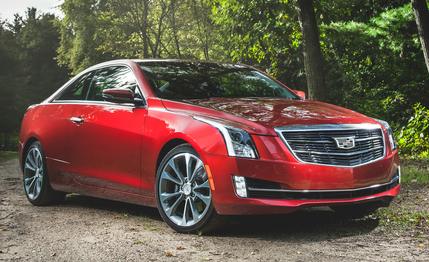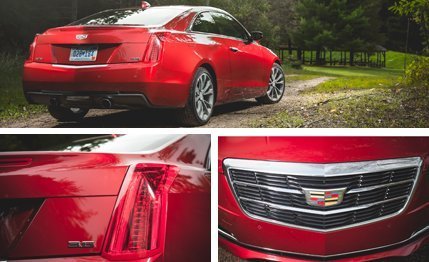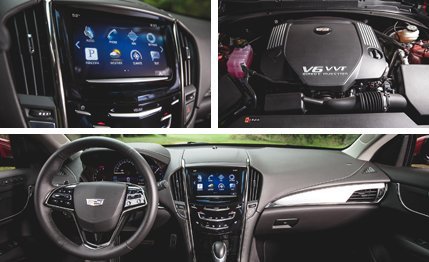 Instrumented Test
Instrumented Test
When the poet John Keats suggested that “a thing of beauty is a joy forever,” it could well have been a description of the new Cadillac ATS coupe—had it not been published in 1818.
Even with a Ouija board, we’ll never know whether Keats was given to prophecy. But in the case of the ATS we can augment Mr. Keats with this corollary: a thing of beauty is more of a joy if it goes fast, thrives on switchbacks, stops in a hurry, and generates a compelling bond with its driver.
The ATS answers positively to all of the above, and anyone who fails to see beauty in this sporty variant needs to visit an optometrist. Soon.
The coupe rolls onto the scene with two engine options—a 272-hp 2.0-liter turbo four-cylinder (standard) and a 321-hp 3.6-liter naturally aspirated V-6, both nourished by direct fuel injection. The two-door model escapes the (disappointingly mundane) base ATS sedan’s 2.5-liter four. The turbo four actually huffs up a little more torque (295 lb-ft versus 275), but the V-6 vectors a bigger herd of ponies to the rear wheels.

In an age of long-stroke engine designs, Cadillac’s V-6 is something of an anomaly: Oversquare (94-mm bore, 85.6-mm stroke) and willing to rev (6800-rpm power peak, 7200-rpm redline), it delivers no-lag throttle response and makes seductive noises as the tach needle spins. Even better, it does all this on regular fuel despite an 11.5:1 compression ratio, thanks to direct injection.
This translates into 18 mpg city and 28 highway on the EPA dynos, and we were pleasantly surprised when, at the conclusion of vigorous testing, we’d recorded 26 mpg. More gratifyingly, we also logged 0 to 60 mph in 5.4 seconds, a quarter-mile run of 14 seconds flat at 102 mph, and a top speed of 146 mph.
Those numbers stack up pretty well versus competition from the Teutonic trio that has long set the pace in the luxo sports coupe (and sedan) biz.
More important, the two-door ATS also does better than hold its own in terms of fancy footwork. High chassis rigidity, a firm suspension (GM’s Magnetic Ride Control), a slightly wider front and rear track than the sedan’s, and quick (2.7 turns lock-to-lock) ZF rack-mounted electric steering combine to provide the sense of connection that prompts drivers to seek the long way home and sends them forth on lengthy weekend forays with no particular destination.
Our test car wore Bridgestone Potenza RE050A RFT summer performance run-flats, staggered front to rear (sized 225/40 and 255/35), on 18-inch aluminum wheels. The combo yielded impressive skidpad grip (0.91 g) and contributed to strong braking performance. In repeated 70-to-0-mph stops, we recorded only six feet of difference between shortest (162 feet) and longest (168), the latter coming first, when the brakes were cold. We recorded no trace of fade.
The little Caddy exhibits gunfighter-quick reflexes, minimal body motions, and nicely weighted steering, although it could benefit from a little more on-center feel. There’s moderate understeer near the limits of adhesion, although those limits are quite high. A minor downside here: Although the suspension is well tuned for athletic responses, it can feel overly stiff, a trait magnified by the run-flat tires, provoking some head toss on gnarly pavement.

While a manual transmission option is limited to the four-cylinder turbo, the six-speed automatic isn’t exactly a comedown. In manual mode, it doesn’t ram shifts home with the authority of, say, an Audi DSG but it’s close, and the transmission will hold shifts against redline—no autonomous upshifting. It also matches revs on downshifts, and it’s seamless in full auto mode.
Weak points? Not many. The rear seat is set up for only two, and if those two are tall their heads will scrape the ceiling. (Solution: Make sure all your friends are under five-foot-ten. Facebook friends exempted.) The front buckets complement a well-appointed, handsomely designed interior, but for a car capable of 0.91 g in cornering, the bolsters should be more pronounced, particularly at the torso. We’re expecting Recaros when the ATS-V is revealed at the L.A. show in November, but this car already performs well enough to warrant more support.
Beyond that, there’s the frustrating CUE touch-screen system, of which Cadillac seems so strangely proud. Don’t forget the ambitious pricing (the 3.6 starts $7155 higher than the 2.0T), but get used to it: Johan de Nysschen, Cadillac’s new boss, doesn’t want the division’s products to be perceived as cut-rate luxury.
Will the ATS stand its ground against luxury-coupe contenders? In our 2012 mano-a-mano sedan comparo—BMW 328i versus ATS 2.0T—the Caddy finished second. But this is a different game with a different body style and a different powertrain.
Considered on its own merits, the ATS 3.6 measures up as an elegant blend of athletic style, gratifying performance, and technical sophistication. It may lack the cachet of a BMW, but it’s a thing of beauty in its own right. We bet Mr. Keats would find joy in it.